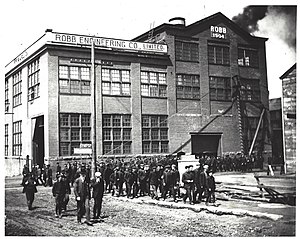| Canadian Labour Revolt | |||
|---|---|---|---|
| Part of the aftermath of World War I and the Revolutions of 1917–1923 | |||
 Machine shop workers walk out during the Amherst general strike | |||
| Date | 2 August 1918 – 11 June 1925 (6 years, 313 days) | ||
| Location | |||
| Resulted in | Failure of the revolt | ||
| Parties | |||
| |||
| Lead figures | |||
The Canadian Labour Revolt was a loosely connected series of strikes, riots, and labour conflicts that took place across Canada between 1918 and 1925, largely organized by the One Big Union (OBU).[1][2]
It was caused by a variety of factors including rising costs of living, unemployment, intensity of work, the unwillingness of employers to recognize unions, and the ongoing international revolution.[3] The One Big Union aimed to overthrow capitalism and the Canadian state and replace it with a socialist system based on worker control of industry and a democratic system with representation based on workplace instead of residential location.[4]
Inspired by the Bolshevik Revolution in Russia and the Spartacist uprising in Germany, labour unions in Canada grew increasingly militant.[5] The revolt commenced with the Vancouver general strike on 2 August 1918. The general strike was violently suppressed by the military, and union offices were ransacked. Victor Midgley, the leader of the strike, was thrown out of a window, and forced to kiss the British flag.[6] The suppression of the strike enraged the labour movement, with many labour leaders and union locals calling for revolution against the Canadian government.[7] At the September 1918 national conference of the Trades and Labor Congress of Canada (TLC), the umbrella organization to which Canadian unions belonged, A. S. Wells, leader of the BC Federation of Labour said "we will have to have our industrial organization similar to that which has proven of such benefit in Russia." The growing radicalism was denounced by the TLC.[5]
In March 1919, radical unions left the TLC and formed the One Big Union.[8] The OBU organized over 100 general strikes by 1925, the most prominent being the Winnipeg general strike.[9] Italian revolutionary Antonio Gramsci proclaimed that in Canada, "Industrial strikes have taken on the overt character of a bid to install a Soviet regime". The Labour Revolt ended unsuccessfully with the defeat of the steel and mine workers at the Battle of Waterford Lake on June 11, 1925.[10]
- ^ Kealey, G. S. (1984). "1919: The Canadian Labor Revolt". Plowing / Le Travail. 13: 11–44. doi:10.2307/25140399. JSTOR 25140399.
- ^ "The 1919 Workers' Revolt was National in Character". Active History. June 17, 2019. Retrieved February 23, 2021.
- ^ Siemiatycki, Myer (1998). "The Great War, the State, and Working-Class Canada". In Heron, Craig (ed.). The Workers' Revolt in Canada, 1917-1925. University of Toronto Press. pp. 11–42. doi:10.3138/9781442682566. ISBN 9781442682566. JSTOR 10.3138/9781442682566.5.
- ^ Berry, David (17 September 2019). "One Big Union". The Canadian Encyclopedia. Retrieved 20 February 2021.
- ^ a b Campbell, Peter (2009). "Understanding the dictatorship of the proletariat: the Canadian left and the moment Of socialist possibility in 1919". Labour / Le Travail. 64: 51+. Retrieved 20 February 2021 – via Gale OneFile: Business.
- ^ Seager, Allen; Roth, David (1998). "British Columbia and the Mining West: A Ghost of a Chance". In Heron, Craig (ed.). The Workers' Revolt in Canada, 1917-1925. University of Toronto Press. pp. 231–267. doi:10.3138/9781442682566. ISBN 9781442682566. JSTOR 10.3138/9781442682566.11.
- ^ "Civilization.ca - Canadian labour history, 1850-1999 - 1919: radical solutions". www.historymuseum.ca. Retrieved 2021-02-20.
- ^ "1919: labour unrest and formation of One Big Union". Alberta History. 53 (2): 17. 2005. Retrieved 20 February 2021 – via Gale In Context: Canada.
- ^ "Canadian labour history, 1850-1999 - Winnipeg general strike". www.historymuseum.ca. Retrieved February 20, 2021.
- ^ Frank, David (23 January 2014). "Cape Breton Strikes 1920s". The Canadian Encyclopedia. Retrieved 20 February 2021.
